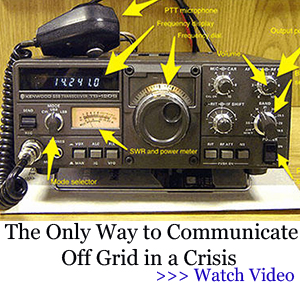![]()
In a world characterized by increased reliance on electronic systems, the potential of disruption to our daily lives due to a failure of these systems seems an ever more likely and inevitable event.
Electronic systems are not impervious, and we often see the devastating results that hackers can have on computer-controlled operations.
EMPs are a seldom mentioned threat, but given their potential to take down power grids and electronic systems, they represent a threat we must take seriously.
EMPs can be the result of nuclear detonations, malicious attacks, or severe solar activity. But no matter their origin, their consequences can cause chaos and endanger lives.
Specific locations will pose a much higher risk to physical safety in the event of an EMP. Careful consideration and proactive planning will enable you to avoid these places and situations and take measures to ensure your survival.
In this article, we will explore the top dangerous locations to avoid during or after an EMP and offer some ideas on mitigating the risks should you find yourself in the midst of these during or after an EMP.
⇒ The First States That Will Go Down During an EMP. Do You Live in the Red Zone? (Video)
The most dangerous places to avoid will invariably be those that rely heavily on vulnerable infrastructure and where the failure of these electronic components can have devastating consequences for public safety. Here is an overview:
Airplanes in Flight
 Airplanes depend on electronics for navigation, communication, and flight automation and control systems.
Airplanes depend on electronics for navigation, communication, and flight automation and control systems.
A strong EMP could disable an aircraft’s ability to navigate, communicate, and control certain functions. Avoid aircraft after an EMP until the craft’s safety can be tested and assured.
Airports
Airports are hubs where travelers congregate. They rely on electronic systems for air traffic control, runway lighting, and communication with aircraft.
Failing electronic systems could lead to chaos on the ground, the inability to get flights into the air, standard passengers, and even the threat of airplane crashes at the airport.
Avoid airports after severe EMPs, and if you find yourself stranded at an airport, stay calm, gather information on the severity of the EMP, and try to find a safe place where you can wait safely until some order is restored.
Highways and Major Roads
Traffic management systems, including toll booths, roadside assistance, and traffic lights, rely heavily on electronic monitoring and control systems.
Related: 12 Things You Need to Know Before Choosing Your Bug Out Location
The failure of these systems due to EMPs could severely disrupt traffic, cause massive gridlock and congestion, and disrupt traffic flow. This could lead to general chaos, increased road rage incidents, and increased accidents. Avoid busy roadways in the aftermath of an EMP.
Subway Systems
 Underground trains depend on electronic signaling and electronic systems to keep trains from crashing into one another.
Underground trains depend on electronic signaling and electronic systems to keep trains from crashing into one another.
They are also reliant on electricity.
EMPs could cause increased crashes or leave passengers stranded in a dark maize maze of underground tunnels.
Stations and platforms could become chaotic due to panic and stranded passengers.
Avoid these underground transportation networks, and always carry a flashlight and physical map of the tunnel systems, preferably one that shows where escape staircases are located.
Train Stations
Above-ground train stations are also heavily reliant on electronic systems for ticketing, signaling, platform management, and electricity to keep trains moving.
A widespread failure of these systems could lead to an increase in overcrowding on trains and platforms and accidents, causing general panic and mayhem and risks to passengers and staff.
Sports Stadiums and Arenas
Sports stadiums depend on electronic ticketing systems, lighting, scoreboards, and security monitoring systems. An EMP event could disrupt these systems, leading to poor crowd management and creating security threats.
Hospitals and Healthcare Facilities
 Many patient care systems depend on electronics.
Many patient care systems depend on electronics.
These include systems for administering medication and monitoring patient health.
Furthermore, electronic systems help with diagnostics and also communicating emergency events.
Widespread disruption of these systems could severely compromise patient safety and the ability of these facilities to function orderly and provide adequate care.
Instead, learn here what the most sough-after medical items will be, and stockpile them before it’s too late.
Shopping Malls and Large Retail Stores
Malls and other retail businesses rely on electronic systems for lighting, air conditioning, escalators, and even security monitoring systems like cameras and theft detection.
With these systems down, general chaos could erupt in malls, leaving shoppers in near darkness and with the possibility of an increase in criminal activity like robbery and looting.
Industrial Facilities
Manufacturing plants rely heavily on electronic monitoring and control systems for operational efficiency and personnel safety.
Widespread disruption of electronics could lead to catastrophic failures in chemical controls, potentially leading to poisonings or explosions.
Processes relying on electricity to stay within safe operation parameters could also destabilize. Avoid industrial facilities where electronic systems control potentially dangerous processes.
Surviving an EMP Event
Here are five essential rules to apply when an EMP strikes:
Stay Informed and Aware
 Stay well informed about potential threats in your surroundings.
Stay well informed about potential threats in your surroundings.
Look for any signs that a failure in monitoring and control systems could be causing dangerous failures.
Adapt to new circumstances as information becomes available.
Protect Vital Electronics
When safeguarding your electronics against the looming threat of an EMP, traditional solutions like Faraday cages may seem practical, but they’re cumbersome and not always reliable.
That’s why I wish more people knew about the EMP Cloth. Developed after extensive research by top U.S. scientists, this cloth offers 98% military-grade protection against electromagnetic waves. From credit cards to generators, fridges, and even cars, it covers everything you need.
They don’t restock them often because they’re pretty tough to make, so it literally took me YEARS to finally get one. After hunting around, I found a reliable website to order it from. I recommend you secure your own cloth from here. It’s a rare find and not many people get to own it, which is a shame.
Be Prepared and Ready
Ensure you have essential survival gear that is not vulnerable to electronic or electrical disruption. Map books, binoculars, medical supplies, food, and lighting will be among the most important.
Prioritize Safety and Security
The immediate aftermath of severe disruptions is usually the most dangerous time. Ensure you can stay sheltered and safe during the initial panic and chaos. Focus on maintaining vigilance and helping others, but avoid potentially dangerous individuals.
Maintain Communication and Connectivity
 Try to stay in communication with others. This will require battery-operated communication devices in Faraday cages or shielded from EMPs. The ability to gather information and communicate will be invaluable.
Try to stay in communication with others. This will require battery-operated communication devices in Faraday cages or shielded from EMPs. The ability to gather information and communicate will be invaluable.
You can learn here how to legally turn a CB car radio into a powerful transmitter capable of emitting and receiving communications from hundreds of miles away.
Adapt and Overcome Challenges
Be ready to respond to changes in circumstances dictated by new information or communications. Be flexible, be prepared to adapt, and prioritize problem-solving. Collaborate as far as possible with others, but remain vigilant and avoid blame allocation and arguments.
Knowing the most sensitive and critical infrastructure that can be damaged during an EMP will allow you to assess threats and plan. Here are some of the most vulnerable sectors and processes.
Power Grid
Power grids, with their extensive distribution networks and electronic control systems, are particularly sensitive to EMPs, which could cause widespread blackouts lasting days or weeks, affecting all emergency services, food preparation and storage, and human comfort and safety.
Financial Institutions
All financial systems rely on immediate access to information for transactions to take place. You may be unable to affect payments in the aftermath of an EMP.
Water and Sewage Systems
Water treatment and pump stations rely on electronic and control systems, not to mention the water grid and reservoirs signaling to the pump station to increase throughput. If this stops working, towns may find themselves without potable water or sewage systems.
Healthcare Facilities
Hospitals and other healthcare facilities may lack the means to deliver safe and adequate healthcare services.
Emergency Services
Police, fire departments, and medical services rely on electronic communication systems. They also have dispatching software and navigation equipment that help them streamline operations and get to where help is needed. When these fail, first responders may be unable to respond to calls for help.
While the threat of an EMP may seem highly improbable, the potential consequences could be devastating. Be prepared for any eventuality, and avoid the places mentioned above should a massive EMP event occur.
You may also like:
 How to Remove Radioactive Particles From Water in Case of a Nuclear Fallout
How to Remove Radioactive Particles From Water in Case of a Nuclear Fallout
The 7 Actions to Take Immediately Following an EMP Strike (Video)
6 Items to Carry if There Are Protests in Your State
Pioneer Recipes Every Prepper Should Learn
DIY Projects to Hide Your Survival Plants in Plain Sight
